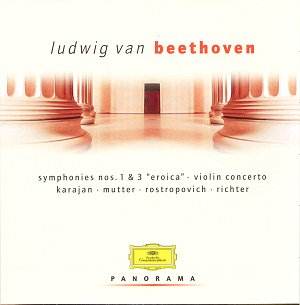Ludwig van BEETHOVEN (1770-1827)
Symphonies a - No. 1 in C, Op. 21; No. 3 in E flat, Op.
33, 'Eroica'. Violin Concerto in D, Op. 61b. Cello Sonata in A,
Op.
69c.
 bAnne-Sophie Mutter
(violin); cMstislav Rostropovich (cello); cSviatoslav
Richter (piano); abBerlin Philharmonic Orchestra/Herbert von
Karajan.
bAnne-Sophie Mutter
(violin); cMstislav Rostropovich (cello); cSviatoslav
Richter (piano); abBerlin Philharmonic Orchestra/Herbert von
Karajan.
 DG Panorama 469 109-2
[ADD]
[149'27]
DG Panorama 469 109-2
[ADD]
[149'27]
Crotchet

There is no denying the sheer force and conviction of Herbert von Karajan's
Beethoven performances, regardless of where one's priorities lie. Both of
the symphonies date from the early sixties. In comparison with Karajan's
EMI accounts with the Philharmonia Orchestra, however, textures are sometimes
overloaded, particularly in the First Symphony. The 'con brio' marking for
the first movement of this symphony is, if not totally ignored, certainly
modified and a certain spring in the step is lacking. To compensate for this,
the speed for the Andante cantabile con moto is well chosen, and the violins
show themselves capable of feather-light articulation in the finale.
Unfortunately the Menuetto needs a breath of life.
The Eroica is preferable. The first movement is surprisingly fleet of foot
and the sheer unstoppable energy of the fugato of the Funeral March is gripping.
The finale, however, returns to an over-smooth conception. These accounts
serve as a reminder of the committed confidence of Karajan. The devotion
of his orchestra is complete.
The Violin Concerto is big-boned (an apt comparison, and a preferable choice
if all things were equal, would be Perlman and Giulini with the Philharmonia
on EMI). Karajan accompanies Mutter magnificently throughout. Whilst Mutter's
first entry seems under-played, her first movement cadenza is simply outstanding,
the slow movement serene, and the last movement continues the robust feel
of the first. However, the stature of the performance of the final piece
on the set dwarfs the rest. The love for the music that Rostropovich and
Richter obviously share shines through their performance of the A major Cello
Sonata. Their experience in chamber music means that they almost play as
one, and it goes without saying that any technical difficulties are brushed
aside.
To end a compilation such as this with chamber music might at first glance
appear to be a miscalculation. Whether by accident or design, however, it
is a masterstroke and it is this performance which makes the cost of the
set worthwhile.
Reviewer
Colin Clarke
Performance
 Symphonies
Symphonies
 Concerto
Concerto
 Cello Sonata
Cello Sonata
Recording

